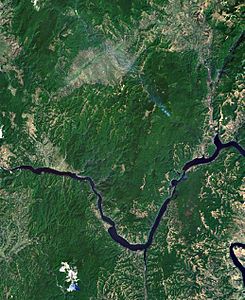Almăj Mountains
| Almăj Mountains | |
|---|---|
|
Location of the Banat Mountains, which includes the Almăj Mountains |
|
|
Almăj Mountains (satellite view) |
|
| Highest peak | Svinecea Mare ( 1224 m ) |
| location | Romania |
| Part of the Banat Mountains | Western Romanian Carpathians |
| Coordinates | 44 ° 37 ′ N , 22 ° 2 ′ E |
The Almăj Mountains (also Almasch Mountains , Romanian Munții Almăjului ) is a mountain range in the Banat Mountains , the southern part of the Western Romanian Carpathians . The Almăj Mountains are located in the Caraș-Severin and Mehedinți districts , in southwest Romania . The highest peak is the Sfinecea Mare at 1224 meters .
Geographical location
The Almăj Mountains can be reached by car from Orșova , Mehadia , Bozovici and Berzasca . Mehadia can also be reached by train and Orșova by train and ship.
description
The Almăj Mountains are bounded in the south by the Danube - Defilee at Orșova- Sichevița , in the west by the Liubcova - Șopotu Nou corridor , in the north by the Almăj and Mehadia Depression , while the Orșova Depression extends to the east .
The highest peak of the Almăj Mountains is the Sfinecea Mare at 1224 meters. Other peaks are: Cârșa Mare (1152 meters), Cherbelezul (1102 meters), Vrapișioanea (934 meters) and Capul Grobanului (1104 meters).
The Almăj Mountains are made up of crystalline slate over which sedimentary rocks such as Mesozoic limestone and sandstone from the Paleozoic and Neozoic Era have been deposited. In Ogradena also is volcanic rock in the form of granite found.
In the limestone, the karst landscape is predominant in the form of:
- Gorges and rock faces : Valea Berzasca, Sirinea, Rudărica Mică, Svinecea peaks
- Sinkholes in Lalca
- Trenches : Svinecea Mare, Bigăr
Numerous caves and grottos can be found underground : Peştera cu Apă de la Lalca , Peştera La Pişătoare , Peştera Zamoniţa , Avenul Rudărica .
The hydrological basin of the Almăj Mountains includes the Nera rivers with the tributaries Ieșelniţa, Mraconia, Valea Morii, Tisovița, Sirinia, Berzasca and Oravița and Cerna with the tributaries Bârzu, Șopot, Rudăria and Putna that make their way to the Danube.
The Almăj Mountains are characterized by a mild Mediterranean climate . On the high peaks of the mountains, the average annual temperature is 6–8 ° C and the annual rainfall is 1000 mm. In the Almăj Depression, the annual averages are 9–10 ° C and the rainfall is 700–800 mm. In the Danube Defile (Sichevița-Orșova), the temperature rises slightly from west to east and rainfall varies between 800 mm in dry years and 1100–1400 mm in rainy years.
flora
The vegetation in the Almăj Mountains has a large forest stand and is represented by the following trees and shrubs :
Common beech ( Fagus sylvatica ), common red fescue ( Festuca rubra ), red ostrich grass ( Agrostis tenuis ), oriental beech ( Fagus orientalis ), hornbeam ( Carpinus betulus ), sessile oak ( Quercus petraea ), manna ash ( Fraxinus ornus ), Cornelian cherry ( Cornus mas ), common lilac ( Syringa vulgaris ).
fauna
The animal world is mainly represented by Central and Eastern European animal species:
Roe deer ( Capreolus capreolus ), red fox ( Vulpes vulpes ), wild boar ( Sus scrofa ), wolf ( Canis lupus ), brown bear ( Ursus arctos ), wild cat ( Felis silvestris ), Eurasian lynx ( Lynx lynx ), stone marten ( Martes foina ), European Badger ( Meles meles ), dormouse ( Glis glis ), squirrel ( Sciurus vulgaris fuscoater ), brown hare ( Lepus europaeus ).
Among the rare birds on the Danube Defilee are the stone grouse ( Alectoris graeca ) and the Egyptian vulture ( Neophron percnopterus )
Reptiles are represented by: the Greek tortoise ( Testudo hermanni ), the European horned viper ( Vipera ammodytes ) and rarely the adder ( Vipera berus )
The fire salamander ( Salamandra salamandra ) is found among the amphibians .
The brown trout ( Salmo trutta fario ) lives in the Berzasca and Sirinia rivers. During their migration on the Danube, sturgeon reach the Danube defile, the best known being the sterlet ( Acipenser ruthenus ).
Nature reserves
The Almăj Mountains are under nature protection , with a large part being affiliated with the Iron Gate Nature Park :
- Sirinia-Cozla nature reserve : geomorphological (ravines, steep limestone cliffs, ditches, springs), floristic and faunistic reserve
- Donaudefilee reserve (215 hectares): botanical reserve for the protection of rare Mediterranean plants: Tulipa hungarica , Irisreichenbachi , Oriental beech ( Fagus orientalis ), Fagus taurica , Oriental hornbeam ( Carpinus orientalis ), Manna ash ( Fraxinus ornus ), tree Hazel ( Corylus colurna ), downy oak ( Quercus pubescens ), French maple ( Acer monspessulanum )
- Svinița fossil deposit (95 hectares) well-preserved animal fossils with more than 60 types of ammonites , brachiopods , corals and snails .
The reserves are not part of the Iron Gate Nature Park:
- Rudăria Gorge (250 hectares): geomorphological (ravines, cliffs , waterfalls ), floristic ( larch ), faunistic ( owls , Banat swifts ) and anthropogenic ( water mills ) reserves
- Globul Gorge (225 hectares): geomorphological (ravines, steep slopes), floristic, faunistic and anthropogenic (water mills) reserve
- Râpa Neagră (5 hectares): geological reserve, trenches in black-gray Lias clay
- Globul Craiovei fossil deposit : paleontological reserve, 2 hectares
- Iardaştița reserve : forest reserve , 501 hectares
Web links
- books.google.de , Urban Schloenbach : The crystalline and older sedimentary formations in the NW. der Almasch , in: Negotiations of the Imperial Royal Geological Institute, Vienna 1869
Individual evidence
- ↑ a b c d e f banatulmontan.wordpress.com , Munţii Almăjului (Romanian)
- ↑ moridinrudaria.uv , Munţii Almăjului (Romanian)

